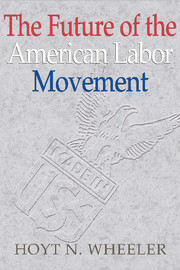Book contents
- Frontmatter
- Contents
- Foreword
- Introduction by Lynn R. Williams
- 1 A Future for the American Labor Movement?
- 2 Industrial Relations in a Time of Change
- 3 A Survey of American Union Strategies
- 4 The Old Reformist Unionism: The Noble Order of the Knights of Labor
- 5 The New Reformist Unionism: CAFE
- 6 A New Version of an Old Reformist Strategy: Employee Ownership
- 7 Social Democratic Unionism in Action: Strategies of European Trade Unions
- 8 A New Twist and TURN on Social Democratic Unionism: Unions and Regional Economic Development
- 9 A Labor Movement for the Twenty-First Century
- Appendix: Interview with John J. Sweeney, President, AFL-CIO
- References
- Index
2 - Industrial Relations in a Time of Change
Published online by Cambridge University Press: 06 July 2010
- Frontmatter
- Contents
- Foreword
- Introduction by Lynn R. Williams
- 1 A Future for the American Labor Movement?
- 2 Industrial Relations in a Time of Change
- 3 A Survey of American Union Strategies
- 4 The Old Reformist Unionism: The Noble Order of the Knights of Labor
- 5 The New Reformist Unionism: CAFE
- 6 A New Version of an Old Reformist Strategy: Employee Ownership
- 7 Social Democratic Unionism in Action: Strategies of European Trade Unions
- 8 A New Twist and TURN on Social Democratic Unionism: Unions and Regional Economic Development
- 9 A Labor Movement for the Twenty-First Century
- Appendix: Interview with John J. Sweeney, President, AFL-CIO
- References
- Index
Summary
Globalization is not the only thing influencing events in the world today, but to the extent that there is a North Star and a worldwide shaping force, it is this system.
Thomas L. Freidman, The Lexis and the Olive Tree, 2000In order to predict the future of the American labor movement, it is necessary to have a firm grasp on the environmental conditions under which it is likely to be operating. If, as argued in Chapter 1, the environment in which the American labor movement operates is believed to be undergoing rapid and dramatic changes, exactly what is the nature of these changes? What are their expected consequences?
THE FORCES MOTIVATING CHANGE
Change in the American workplace has been motivated by a powerful conjunction of forces and circumstances. These have included globalization and the resulting increased competition (both domestic and international), technological change, the shift from manufacturing to services, workforce developments, and an increased receptiveness to change on the part of managers, workers, and unions.
Globalization is a system that has powerful implications for all aspects of American society. It has been compellingly argued that “Globalization is not just some economic fad, and it is not just a passing trend. It is an international system – the dominant international system …” (Friedman 2000: 7). Globalization has been defined as “the inexorable integration of markets, nationstates and technologies to a degree never witnessed before” (Friedman 2000: 9).
- Type
- Chapter
- Information
- The Future of the American Labor Movement , pp. 25 - 48Publisher: Cambridge University PressPrint publication year: 2002



